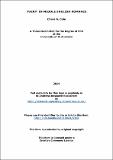Files in this item
'Fairy' in Middle English romance
Item metadata
| dc.contributor.advisor | Purdie, Rhiannon | |
| dc.contributor.author | Cole, Chera A. | |
| dc.coverage.spatial | 257 | en_US |
| dc.date.accessioned | 2015-03-27T11:50:39Z | |
| dc.date.available | 2015-03-27T11:50:39Z | |
| dc.date.issued | 2014-06-24 | |
| dc.identifier.uri | https://hdl.handle.net/10023/6388 | |
| dc.description.abstract | This thesis, ‘Fairy in Middle English romance’, aims to contribute to the recent resurgence of interest in the literary medieval supernatural by studying the concept of ‘fairy’ as it is presented in fourteenth- and fifteenth-century Middle English romances. This thesis is particularly interested in how the use of ‘fairy’ in Middle English romances serves as an arena in which to play out ‘thought-experiments’ that test anxieties about faith, gender, power, and death. The first chapter considers the concept of fairy in its medieval Christian context by using the romance Melusine as a case study to examine fairies alongside medieval theological explorations of the nature of demons. The thesis then examines the power dynamic of fairy/human relationships and the extent to which having one partner be a fairy affects these explorations of medieval attitudes toward gender relations and hierarchy. The third chapter investigates ‘fairy-like’ women enchantresses in romance and the extent to which fairy is ‘performed’ in romance. The fourth chapter explores the location of Faerie and how it relates as an alternative ‘Otherworld’ to the Christian Otherworlds of Paradise, Purgatory, Heaven, and Hell. The final chapter continues to examine geography by considering the application of Avalon and whether Avalon can be read as a ‘land of fairies’. By considering the etymological, spiritual, and gendered definitions of ‘fairy’, my research reveals medieval attitudes toward not only the Otherworld, but also the contemporary medieval world. In doing so, this thesis provides new readings of little-studied medieval texts, such as the Middle English Melusine and Eger and Grime, as well as reconsider the presence of religious material and gender dynamics in medieval romance. This thesis demonstrates that by examining how fairy was used in Middle English romance, we can see how medieval authors were describing their present reality. | en_US |
| dc.language.iso | en | en_US |
| dc.publisher | University of St Andrews | |
| dc.relation | Sir Orfeo | en_US |
| dc.relation | Melusine | en_US |
| dc.relation | Sir Launfal | en_US |
| dc.relation | Sir Degare | en_US |
| dc.relation | Eger and Grime | en_US |
| dc.relation | Partonope of Blois | en_US |
| dc.relation | Le Morte D'arthur | en_US |
| dc.rights | Creative Commons Attribution-NonCommercial-NoDerivatives 4.0 International | |
| dc.rights.uri | http://creativecommons.org/licenses/by-nc-nd/4.0/ | |
| dc.subject | Middle English romance | en_US |
| dc.subject | Medieval literature | en_US |
| dc.subject | Fairy | en_US |
| dc.subject | Fairies | en_US |
| dc.subject | British literature | en_US |
| dc.subject | Medieval romance | en_US |
| dc.subject.lcc | PR255.C7 | |
| dc.subject.lcsh | Romances, English--History and criticism | en_US |
| dc.subject.lcsh | English literature--Middle English, 1100-1500--History and criticism | en_US |
| dc.subject.lcsh | Fairies in literature | en_US |
| dc.subject.lcsh | Melusine (Legendary character)--Romances--History and criticism | en_US |
| dc.title | 'Fairy' in Middle English romance | en_US |
| dc.type | Thesis | en_US |
| dc.type.qualificationlevel | Doctoral | en_US |
| dc.type.qualificationname | PhD Doctor of Philosophy | en_US |
| dc.publisher.institution | The University of St Andrews | en_US |
This item appears in the following Collection(s)
Except where otherwise noted within the work, this item's licence for re-use is described as Creative Commons Attribution-NonCommercial-NoDerivatives 4.0 International
Items in the St Andrews Research Repository are protected by copyright, with all rights reserved, unless otherwise indicated.


